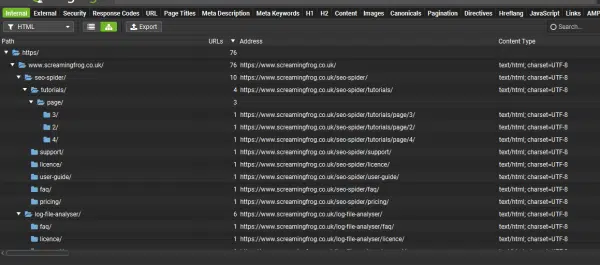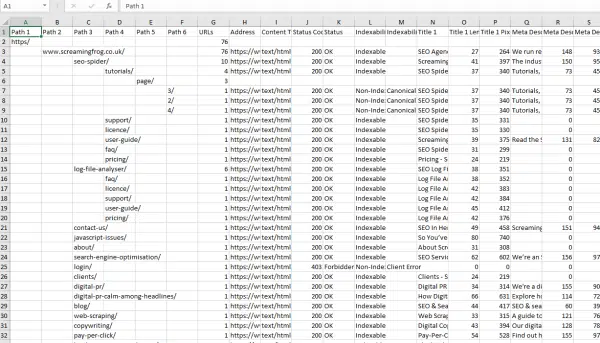Product detail page (PDP) optimization is very important for e-commerce websites. Properly optimizing your product pages will increase organic traffic, increase conversions, and increase revenue.
This comprehensive guide covers the key elements of effective product page optimization, including:
1. Product page URL
Clear and descriptive URLs improve both user experience and visibility. Ideally, you should describe what content the page contains.
It’s important to optimize your URLs for clarity and user-friendliness, rather than just keyword stuffing. Remember, its main purpose is to guide the user.
A good product page URL would look like this:
https://brand.com/category/subcategory/color-product
Identify uncategorized product pages and improve your site structure
Some products may be linked directly to the domain and listed alongside the main category.
The risk is that these pages will be treated the same as the main category, which may result in some products not displaying properly and causing confusion.
To find these uncategorized products:
- Crawl your website using Screaming Frog.
- Then click the directory tree icon. internal tab.


- You'll notice that the internal tabs have changed to directory trees.


- click export. This will export your site to a spreadsheet in directory tree format.


This spreadsheet allows you to see the main categories and subcategories, and find products that may have been uploaded without categories or other irregularities in your website's site structure.
2. Image optimization
If you work for a brand that prioritizes minimal text on the page (such as a luxury brand), or if you are required to have no text on key pages, images become very important. They serve the same purpose as text and convey content to search engine crawlers. This allows image optimization. Must For SEO strategy.
Image URL
High-quality images are essential to showcase your products. The filenames for these images must be descriptive and include the following:
- domain
- Product type
- color or size
- Major features
This is a perfect example of Chanel.
https://www.chanel.com/images//t_one///q_auto:good,f_auto,fl_lossy,dpr_1.1/w_840/small-classic-handbag-black-grained-calfskin-gold-tone-metal-grained-calfskin-gold-tone-metal-packshot-artistique-vue1-a01113y01864c3906-9535401164830.jpg
This URL describes the following product to Google:


Image alt text
Alt text is probably the most important content component of an image. This element helps search engines understand what the image is about.
surely Optimize image alt text for web accessibility. Assist visually impaired users. This is not an opportunity for keyword stuffing.
example:CHANEL Medium Double Flap Caviar Leather
- Product page URL
https://www.chanel.com/us/fashion/p/A01113Y01864C3906/small-classic-handbag-grained-calfskin-gold-tone-metal/ - Image alt text
Img alt="Small Classic Handbag - Black - Grained Calfskin & Gold-Tone Metal - CHANEL - artistique view 1 - see full sized version"
image schema
Implementing schema across images and product pages provides search engines with content and context to understand your pages.
Let's dig deeper:
Get the daily newsletter search that marketers rely on.
3. Product description
Once a customer is influenced by an ad or campaign on TikTok, it takes only a short amount of time to get them to stay and convert after they visit your product page.
Similar to product images, descriptions are important in convincing customers to buy or abandon the idea of buying.
There are several important considerations regarding product descriptions.
- Popup: Depending on your category, you may need to add a pop-up, such as food to remind you about allergies. However, if you are not in a health-related or high-risk category, try to delay the pop-up. If you have a high-value product, showing too many popups may not convince people to buy it. In fact, they might change their mind and leave the website without buying anything.
- Keep product descriptions concise and easy to read. Too much information, buttons, labels, and discounts can overwhelm customers and result in abandonment.
- Avoid duplication of content For similar products. If there are potential duplicates or similarities, ensure that normalization is in place to differentiate product descriptions and pages.
- Make sure to prepare hreflang This applies not only to product descriptions in the same language, but also to different languages and international versions of the site.
- Avoid keyword stuffing. It looks like spam so it's useless. Include as few keywords as necessary, but don't go overboard. Remember, your product description is meant to persuade users, not just Google.
Velvet Powder Puff became a huge sensation at the beginning of 2023. The product description was accurate and the excellent sales pitch, which included a how-to guide, encouraged affected customers to buy immediately.


Let's dig deeper: How to make your ecommerce content more useful
AI and product description generator
Using a product description generator can be a double-edged sword. On the one hand, it brings efficiency and consistency, especially for companies with large product inventories. However, the downside of these generators is that they may lack the unique human touch that makes product descriptions more appealing and persuasive.
If you have a large website with hundreds of products, you may be able to hire a copywriter. If so, please do that instead.
If you have a small site, we recommend that you either create it yourself or take the time to create it. As long as these product descriptions are checked and approved by a copywriter or brand manager before publication, using generative AI is fine.
Otherwise, you may end up creating content just to be featured on product pages, which could lead to content being abandoned.
Let's dig deeper: How to generate product descriptions at scale using ChatGPT
4. User-generated content on PDP increases organic and direct traffic
UGC such as customer reviews and Q&A can greatly enhance your SEO. Provide fresh, relevant content that search engines love. Encouraging UGC on your product pages can also increase trust and engagement among your users.
Creating a content hub for user-generated content allows you to create other content, such as research and data, and use these resources to market to journalists and papers to get coverage and links.
example:Charlotte Tilbury Flawless Filter Foundation


This is a product page with a high conversion rate. This is a product page that aims to convert already influenced customers rather than satisfy search engines.
In some niches, user-generated content increases page conversion rates. For this foundation, seeing different shades of the product and different skin types in real photos is the final push to convert.
Note: Use this type of content only when it's relevant to your field of expertise. Otherwise, it will look out of place and may lead to abandonment rather than conversion.
Let's dig deeper: Why e-commerce brands need to showcase authentic EEAT
5. Global adaptation
Global adaptation involves more than just translation. This includes:
- cultural customization: Understand the cultural nuances and preferences of different regions. Do not use machine translation. If you use an agency, make sure they have a copywriter who can tailor your content to the target country.
- local SEO: Use region-specific keywords and phrases.
- pricing strategy: Adjust prices to reflect local market conditions and purchasing power.
- Payment method: What payment methods are accepted in these countries? PayPal? Or Klarna? Do people prefer paying in installments?
Let's dig deeper: 15 SEO Localization Do’s and Don’ts: Address Cultural Sensitivity
Create useful product pages for your customers
Product page optimization is an ongoing process that requires a strategic and multifaceted approach. The above tips are a great starting point for enhancing your PDP.
Focus on creating pages that attract users while also appealing to search engines. Test different optimization strategies and adjust them based on performance data.
Over time and consistency, an optimized product page becomes a powerful driver of intrinsic growth and revenue.
The opinions expressed in this article are those of the guest author and not necessarily those of Search Engine Land. Staff authors are listed here.


